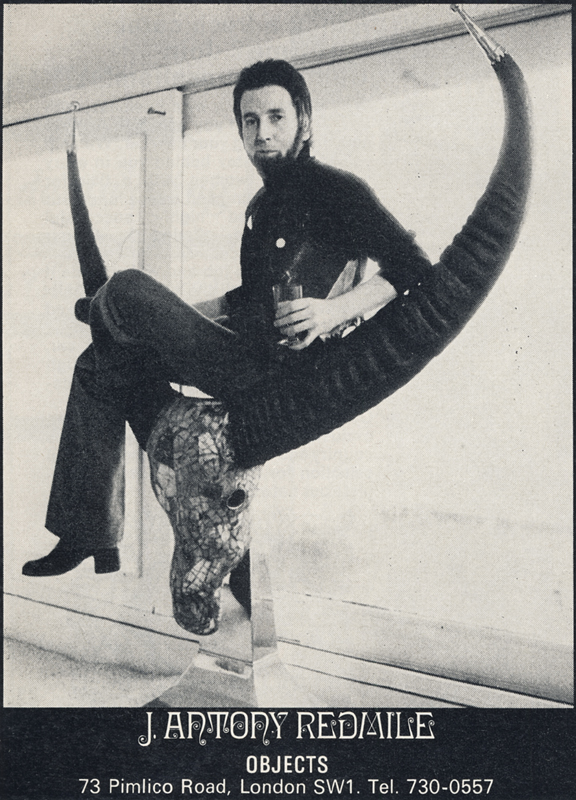A Conch and Molluscan Shell, Coral, Malachite, Lapis-Lazuli, Mother-of-Pearl and Precious Stone Encrusted Dressing Table Mirror Together with a Conch and Molluscan Shell, Coral, and Rock Crystal Encrusted Console
By J. Antony Redmile, circa 1975
Mirror: 33 ½ in (85 cm) high, 25.2 in (63.8 cm) wide, 14 in (35.5 cm) deep
Console: 32 ½ in (82.5 cm) high, 31 in (78.7 cm) wide, 12 in (30.5 cm) deep
cf. Ena Kendall, 'A Room of My Own: J. Antony Redmile', The Observer , 18th December 1988, p.62-63
Console: 32 ½ in (82.5 cm) high, 31 in (78.7 cm) wide, 12 in (30.5 cm) deep
cf. Ena Kendall, 'A Room of My Own: J. Antony Redmile', The Observer , 18th December 1988, p.62-63
At once both outrageous and elusive, J. Antony Redmile drew on his own eclectic tastes to create unique and eye-catching pieces. Perhaps best known for his distinctive antler furniture, Redmile loved using a wide range of materials in his pieces. In the 1980s, he was importing around 2,000 ostrich eggs a year (all infertile – despite his exotic taste in materials, he was always conscientious about sourcing them), as well as large quantities of green malachite.
His own home in Pimlico reflected this love of the unusual – as well as his insatiable collecting. Describing himself as a 'maximalist', Redmile filled his house to bursting point with an array of furniture and decorative arts as varied as the pieces he produced. He described his taste as drawing on the ethos of the 18th and 19th centuries, when collectors acquired with abandon and displayed their pieces in a manner that would today be considered overcrowded and confusing. Redmile, however, found inspiration in this mixture of Victorian clutter and Enlightenment curiosity in nature and the exotic. His delight in this period of overlapping interests explains his fascination not only with the unusual and bizarre, but also with neo-classical design (a combination reflected in some of his own furniture, such as a small Thomas Hope gilt chair, re-upholstered with zebra skin).
Redmile also drew on his extensive travels for inspiration. For a time, he had a workshop in India and came to love the country, developing a close relationship with its culture and people. He was also interested in some of the more unsettling or even macabre pieces produced by distant cultures (again reflecting 19th-century tastes). In his own vast collection, he had a Pygmy skull (which he turned into a candle-holder) and the skull of a Tibetan monk, one of a suitcase-full he brought back himself from his visits.
These diverse inspirations are clearly visible in Redmile's work, and have excited the imaginations of numerous clients, including Joan Collins and Jackie Onassis. While not all who acquire a Redmile piece may place it in rooms as densely filled his own, a single piece distils the essence of his imagination and may serve to inspire new tastes and collections.
His own home in Pimlico reflected this love of the unusual – as well as his insatiable collecting. Describing himself as a 'maximalist', Redmile filled his house to bursting point with an array of furniture and decorative arts as varied as the pieces he produced. He described his taste as drawing on the ethos of the 18th and 19th centuries, when collectors acquired with abandon and displayed their pieces in a manner that would today be considered overcrowded and confusing. Redmile, however, found inspiration in this mixture of Victorian clutter and Enlightenment curiosity in nature and the exotic. His delight in this period of overlapping interests explains his fascination not only with the unusual and bizarre, but also with neo-classical design (a combination reflected in some of his own furniture, such as a small Thomas Hope gilt chair, re-upholstered with zebra skin).
Redmile also drew on his extensive travels for inspiration. For a time, he had a workshop in India and came to love the country, developing a close relationship with its culture and people. He was also interested in some of the more unsettling or even macabre pieces produced by distant cultures (again reflecting 19th-century tastes). In his own vast collection, he had a Pygmy skull (which he turned into a candle-holder) and the skull of a Tibetan monk, one of a suitcase-full he brought back himself from his visits.
These diverse inspirations are clearly visible in Redmile's work, and have excited the imaginations of numerous clients, including Joan Collins and Jackie Onassis. While not all who acquire a Redmile piece may place it in rooms as densely filled his own, a single piece distils the essence of his imagination and may serve to inspire new tastes and collections.



















